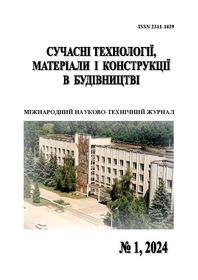USE OF TRADITIONAL AND INNOVATIVE THERMAL INSULATION MATERIALS FOR WALL INSULATION OF RESIDENTIAL AND PUBLIC BUILDINGS
DOI:
https://doi.org/10.31649/2311-1429-2024-1-41-51Keywords:
natural gas production dynamics, housing insulation, energy sector destruction and restoration, electric heating, thermal insulation materialsAbstract
The aim of the work is to study the current state of energy supply for residential maintenance under conditions of excessive
energy resource consumption. It is shown that approximately 80% of the existing housing stock was built with low thermal
resistance indicators of enclosing structures. The dynamics of the absolute volumes of domestic natural gas production and its
import are presented.
Due to Ukraine's refusal to import natural gas, a large-scale transition to electric heating of new residential buildings is anticipated. An analysis of the current state of the energy sector and plans for the construction of new electricity generation
capacities is provided. Electric heating of new housing is complicated by the destruction of energy facilities and transformer
substations. Due to the destruction of the country's energy infrastructure, the government has made the unpopular decision to
raise electricity tariffs. It is shown that thermal insulation of the housing stock will significantly reduce the consumption of energy resources and aligns with global trends in reducing greenhouse gas emissions, contributing to Ukraine's fulfillment of its international commitments to decarbonize the environment according to the decisions of the Paris Conference of 2015. An analysis of the operational properties of traditional thermal insulation materials, such as polystyrene foam and mineral wool, is provided. It is shown that polystyrene foam is an affordable and effective insulator, with its main drawback being flammability, while mineral wool is energy-intensive to produce but is non-flammable. The prospects for using non-combustible low-density aerated concrete, which is common in EU countries, are shown. The global experience of using aerogel as an innovative thermal insulation material is summarized, demonstrating its use as a high-performance insulation material.
References
Fesanghary M. Design of low mission and energy efficient residential building using a multi objective optimization algorithm /M. Fesanghary, S. Asadi, Z.W. Geem // Building and Environment. - #49. - 2012. - R. 245–250.
World Energy Outlook 2022 https://www.iea.org/reports/world-energy-outlook-2022.
Government portal: Thermal modernization of residential buildings and budget institutions is one of the priority issues of Ukraine's policy in the field of energy efficiency. www.kmu.gov.ua.
NCRECP reviewed the maximum prices for electricity for business. https://www.epravda.com.ua/news/2023/06/27/701612/.
Serdyuk V.R., Franishyna S.Yu., Serdyuk T.V., Hristych O.V. Organizational and technological measures of thermal modernization of the outdated fund. VPI Bulletin. 2022. No. 2. – P.6-17.
Chervyakov Yu.M. Cellular concrete - effective wall material / Yu.N. Chervyakov // Building materials and products. 2008. No. 6 (52). - P. 35-36.
Serdyuk V.R., Rudchenko D.G. Growth of production volumes and areas of use of aerated concrete blocks. VPI Bulletin. 2021. No. 5. - P. 7-17.
Market for autoclaved aerated concrete (AAC) Research And Markets.com Electronic resource. Access mode: https://www.researchandmarkets.com/r/6fmucz.
Aerogels/Ed.J. Fricke. – Berlin; Heidelberg; New York; Tokyo: Springer Verlag, 1986. - 205 p.
Airgel thermal insulation for industry https://est-est.prom.ua/ua/g24123390- aerogelnaya-teploizolyatsiya-dlya.
Downloads
-
pdf (Українська)
Downloads: 112



